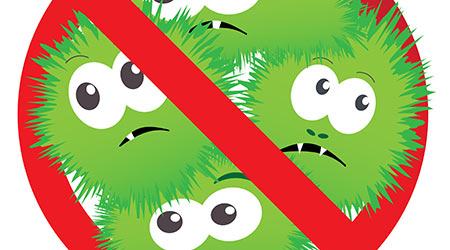
The cold and flu is prevalent this time of year because as the weather turns colder, more people hunker down indoors. But there are myths about how infections are spread. To clear things up, Cintas Corporation outlined eight common misconceptions about restroom cleanliness and hygiene.
1. It doesn’t matter how long I wash my hands as long as I use soap – False
Evidence suggests you should scrub your hands with soap for a minimum of 15 to 30 seconds to effectively remove germs. However, the Centers for Disease Control and Prevention (CDC) found that many other countries and global organizations have adopted recommendations to wash hands for 20 seconds.
For more information on how to prevent the spread of infection, as well as positioning soaps and sanitizers and encouraging handwashing among building occupants, click here.
2. Hand sanitizers can replace washing your hands with soap and water – False
Washing hands with soap and water is the best and most effective way to reduce the number of microbes and germs on hands. Although alcohol-based hand sanitizers can quickly reduce the number of microbes on hands in some situations, the CDC stresses that they are not as effective as soap and water when it comes to removing and inactivating gastrointestinal illness-causing germs such as Cryptosporidium, norovirus and Clostridium difficile.
There are advantages to facilities offering both soap and sanitizer options to building occupants. For more information on the differences between the products and advantages to offering both, click here.
3. The hotter the water used for handwashing, the better – False
Studies show that water temperature does not affect microbe removal. In fact, studies done by the International Association for Food Protection found that there is no research to prove that higher temperatures improve handwashing at all.
4. You don’t have to dry your hands after washing them – False
Studies show that germs can be transferred more easily to and from wet hands, according to the National Center for Biotechnology Information (NCBI), U.S. National Library of Medicine.
According to researchers at the Mayo Clinic, hand drying has not been widely promoted and is often overlooked in conversations about disease prevention. But the CDC reports that the transmission of bacteria is more likely to occur from wet hands than from dry hands. Proper hand drying after washing is an essential component to an overall hand hygiene program.
5. Hand dryers are more hygienic than paper towels – False
Research from NCBI shows that paper towels can help remove bacteria, unlike air dryers which can increase bacteria counts. Paper towels are also less likely to contaminate other restroom users as air dryers have also been shown to spread bacteria between three and six feet from the device, increasing the chances of cross-contamination.
6. Hand dryers work faster – False
Studies indicate it takes approximately 10 seconds to dry hands using a paper towel, while the NCBI claims air dryers require 40 seconds to achieve similar dryness.
7. I need to squat, hover or use a seat protector to stay safe from germs on toilets – False.
Contrary to popular belief, toilet seats are one of the most often cleaned parts of a restroom.
8. The stall furthest from the restroom door is the least used and therefore the cleanest – False
People tend to skip the first stall in favor of stalls farther back to have a little more privacy. Because the first stall is used least often, Dr. Mehmet Oz, MD commented on Sharecare.com that it’s most likely the cleanest.
Even if building occupants practice proper hand hygiene, it’s important for facilities to plan for additional cleaning and disinfection during winter months to keep restrooms clean.

 The Down and Dirty on Cleaning in Virus Season
The Down and Dirty on Cleaning in Virus Season How Surfactant Use is Expanding in Commercial Cleaning
How Surfactant Use is Expanding in Commercial Cleaning Clean Buildings Conference
Clean Buildings Conference